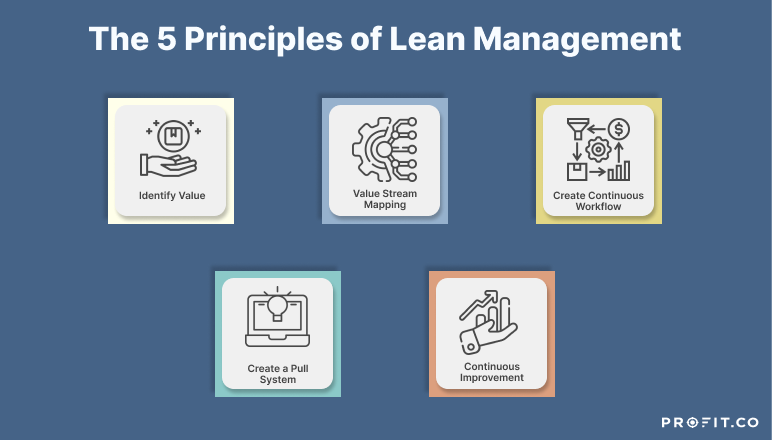Lean management refers to organizing and managing workflows to enhance business performance.
The success and sustainability of a business or company depends on two essential components: quality and efficiency. Lean management is a universal tool that aims to deliver quality and efficiency by optimizing workflows.
Effective leadership is putting first things first. Effective management is discipline, carrying it out.
Lean helps achieve better quality products within a shorter duration and at lower costs. It maximizes the product value and minimizes wastage to enhance your business.
Let’s explore lean management, the main principles, benefits, and some examples you can use to integrate it into your business.
Key Takeaways
Lean management is a set of guidelines that help to stabilize your business. You can identify the real issues in your business and manage them.
- The main goal of lean management is to build value for the customer by optimizing the available resources
- Lean management principles help develop a stable workflow depending on the current customer demands
- Lean management involves continuous improvement to ensure all employees participate in the improvement process
What is Lean Management?
First, what is lean? Lean generally means “no-frills.” It’s a method of removing unnecessary tasks and minimizing waste in the production system without affecting productivity.
Lean management touches on workflow management and organization. The goal is to maximize the value of your service or product to the customer. You’re able to minimize waste without affecting the product’s quality.
The lean management process came from Toyota’s production system. When the workflow became free of interruptions, there was no need for extra space to store idle materials. The amount of waste and re-do loops also reduced.
Lean management minimizes or eliminates the time you spend on unnecessary tasks or operations that complicate business processes and lower the quality.
Principles of Lean Management

Lean management connects the customer value with the production process and the people involved. The main principles of lean are:
1. Identify Value
Every business or company aims to provide products or services that customers can willingly pay for.
The value of your product or service is in the ability to resolve the customers’ issues. It’s the part of the solution that customers pay for. All other processes or tasks that don’t contribute to the end product’s value get wasted.
For this reason, it’s essential to start by identifying the value you want to offer your customers. Defining the value helps you determine the next step.
2. Value Stream Mapping
This principle requires you to map your business’s or company’s workflow. It should include all the people and activities that help the end product reach your customers.
Value stream mapping is the best way to identify and remove the tasks or processes that add no value to the product.
Adopting this principle highlights the areas that add value, those that don’t, and to what extent. It makes it easier to match the processes with the right teams. You can determine the respective teams, who should monitor, measure, evaluate and improve every process.
3. Create Continuous Workflow
Once you master your business’s value stream, you must ensure that every team’s workflow is always smooth. It’s a process that may take some time to implement.
Developing or enhancing a product or service requires collaboration between various teams or departments. Keep in mind that interruptions and bottlenecks can happen unexpectedly.
However, you can identify and eliminate obstacles by visualizing the workflow and breaking down the work into smaller tasks.
4. Create a Pull System
Workflow stability helps your teams finish tasks faster, using less effort. Achieving this stability requires creating a pull or traction system inside the lean management framework.
Such a system ensures that work gets pulled or produced when there’s demand, helping to optimize the resource capacity by mobilizing resources only when there’s a need.
Think of it as a sit-down restaurant. When you walk in and place your order, there’s a waiting period as the chef prepares your meal. The chef doesn’t cook various dishes in advance and then waits for orders because if there’s no actual demand, these dishes will waste resources.
5. Continuous Improvement
Once you implement these steps, you have successfully developed your lean management system. Keep in mind that your new system is not static or isolated.
Issues can come in at any point in the process. It’s best to ensure that team members at all levels participate in the continuous process improvement.
You can use various techniques to promote continuous improvement. For instance, every team can meet daily to discuss the progress, what requires improvement, and possible challenges.
Benefits of Lean Management
Lean principles work together to improve all aspects of the workflow. It involves all management levels in your business or company.
The main benefits include:
Improving Focus
Implementing lean management makes it easier to minimize wastage. You can focus your workforce on activities that build the value of your business.
Enhancing Efficiency and Productivity
When all team members focus on ensuring value, they are more efficient and productive. There will be minimal distractions from unnecessary or unproductive tasks.
A Smarter System
Implementing a pull or traction system ensures you utilize work only when there’s demand.
More Efficient Use of Resources
If you base production on actual demand, you’ll only use the required resources, minimizing waste and making your teams more flexible to handle the dynamic customer needs faster.
The lean management principles help you develop a stable production system. You’ll have better chances of enhancing the overall performance.
Examples of Lean Management Applications
Lean management benefits the entire business by enhancing the whole value stream, not just one isolated aspect.
Some famous examples are:
John Deere
John Deere successfully implemented a lean management system in their business. By automating most quality control mechanisms, they can check more parts for defects within a shorter time.
These control systems can track the production of each part or product, ensuring the output doesn’t exceed the demand and uses valuable resources.
Therefore, they can supply more products at lower production costs and better prices for their customers.
Nike
Nike brand is famous for designing and producing athletic shoes and apparel. They implemented the lean management system to build value in their products by improving internal processes.
Nike achieves lean management by setting specific goals that align with the company’s products and mission. They managed to increase the output by 20% while reducing the CO2 emissions by 6%.
This ensured market stability and reduced the defective products by 50%. Lean manufacturing also brought unexpected benefits, such as lowering poor work practices by about 15%.
Conclusion
Savvy business executives continue adopting lean management in their business processes, minimizing waste and optimizing value to the consumer benefits the company and the customers
However, it’s not an overnight transformation. It’s a continuous process that requires evaluation to see how to improve the workflows. With lean, you can deliver better products and services within a shorter time and at minimal costs.
The right OKR management software can help manage your goals right alongside your projects. OKRs help connect day-to-day tasks and projects with high-level goals so employees know that their work matters for the company’s success. Profit.co enables teams to transparently track their OKRs so they can focus on their priorities, measure their progress, and achieve their goals!
You can get started on Profit.co today completely free. To learn more about Profit.co and how you can incorporate your existing processes with this all-in-one OKR, task, performance, and employee engagement software, book a free demo with our experts today!

